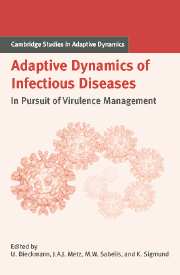Book contents
- Frontmatter
- Contents
- Contributing Authors
- List of Boxes
- Notational Standards
- 1 Introduction
- A Setting the Stage
- B Host Population Structure
- C Within-Host Interactions
- D Pathogen–Host Coevolution
- Introduction to Part D
- 13 Coevolution of Virus and Host Cell-death Signals
- 14 Biogeographical Perspectives on Arms Races
- 15 Major Histocompatibility Complex: Polymorphism from Coevolution
- 16 Virulence Management and Disease Resistance in Diploid Hosts
- 17 Coevolution in Gene-for-gene Systems
- 18 Implications of Sexual Selection for Virulence Management
- 19 Molecular Phylogenies and Virulence Evolution
- E Multilevel Selection
- F Vaccines and Drugs
- G Perspectives for Virulence Management
- References
- Index
- International Institute for Applied Systems Analysis
13 - Coevolution of Virus and Host Cell-death Signals
Published online by Cambridge University Press: 15 January 2010
- Frontmatter
- Contents
- Contributing Authors
- List of Boxes
- Notational Standards
- 1 Introduction
- A Setting the Stage
- B Host Population Structure
- C Within-Host Interactions
- D Pathogen–Host Coevolution
- Introduction to Part D
- 13 Coevolution of Virus and Host Cell-death Signals
- 14 Biogeographical Perspectives on Arms Races
- 15 Major Histocompatibility Complex: Polymorphism from Coevolution
- 16 Virulence Management and Disease Resistance in Diploid Hosts
- 17 Coevolution in Gene-for-gene Systems
- 18 Implications of Sexual Selection for Virulence Management
- 19 Molecular Phylogenies and Virulence Evolution
- E Multilevel Selection
- F Vaccines and Drugs
- G Perspectives for Virulence Management
- References
- Index
- International Institute for Applied Systems Analysis
Summary
Introduction
The death of a cell is no longer thought of as something undesirable for the individual. It is understood that cell death is an essential complement to cell division, without which the building of complex multicellular organisms would be impossible. Programmed cell death, or apoptosis, is the mechanism by which cells are eliminated by proteins encoded by the host genome. The genes that code for these proteins have been found in all eukaryotic organisms investigated, and are recognized as homologous (Vaux et al. 1994). It is customary to distinguish apoptosis from necrosis, a series of irreversible changes to the cell following injury. During necrosis, a swelling of the cytoplasmic membranes culminates in rupture and the release of lysosomal enzymes. In vivo, necrosis is often accompanied by an inflammatory response. During apoptosis, compaction and segregation of nuclear chromatin is accompanied by a convolution of the plasma membranes. These membranous folds give rise to “apoptotic bodies” filled with densely packed organelles. Apoptosis is also associated with double-strand cleavage of nuclear DNA between nucleosomes, which results in a “ladder” oligonucleosomal fragments on an electrophoretic gel (Wyllie 1987). Apoptosis has been further divided into heterophagic (type I) and autophagic (type II) mechanisms, the latter of which appears similar to necrosis. Conventionally, type I apoptosis is seen in highly mitotic lines or in the reticuloendothelial system, and involves nuclear collapse, condensation of chromatin, and cell fragmentation.
- Type
- Chapter
- Information
- Adaptive Dynamics of Infectious DiseasesIn Pursuit of Virulence Management, pp. 183 - 196Publisher: Cambridge University PressPrint publication year: 2002
- 1
- Cited by



